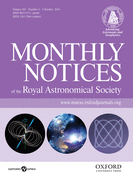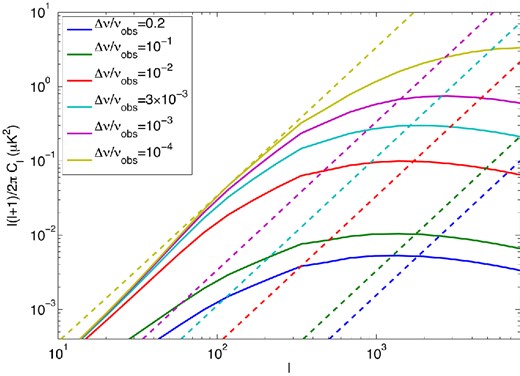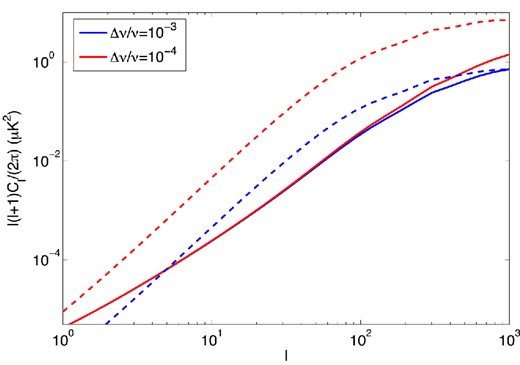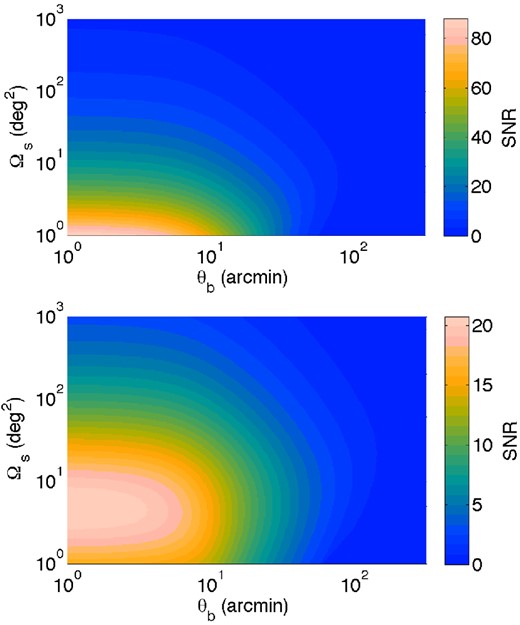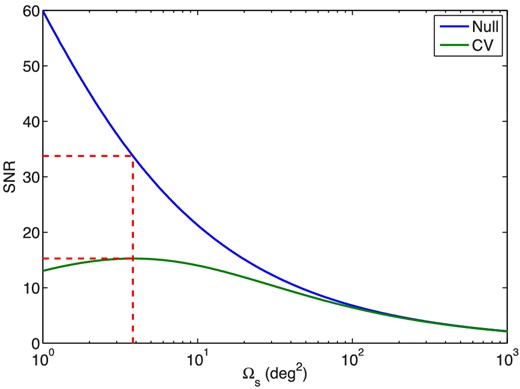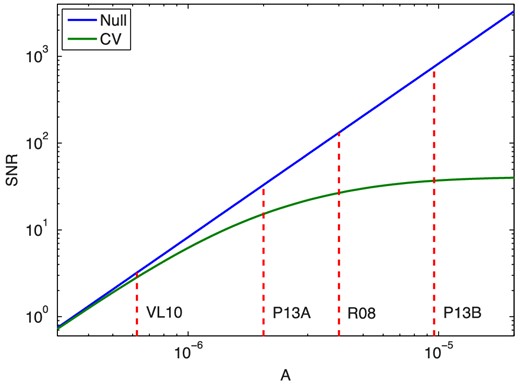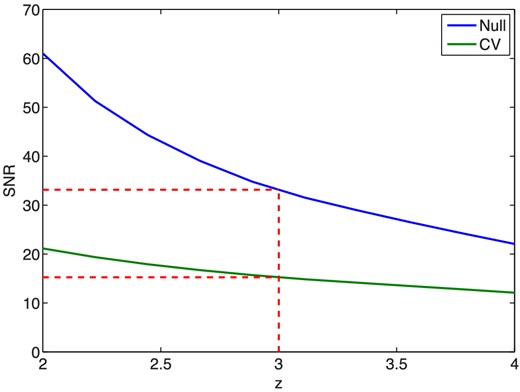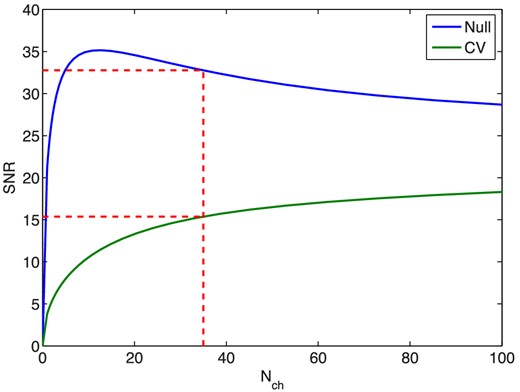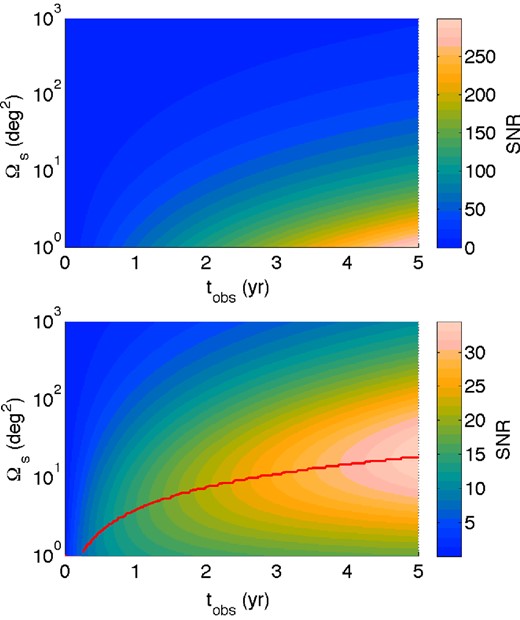-
PDF
- Split View
-
Views
-
Cite
Cite
Patrick C. Breysse, Ely D. Kovetz, Marc Kamionkowski, Carbon monoxide intensity mapping at moderate redshifts, Monthly Notices of the Royal Astronomical Society, Volume 443, Issue 4, 1 October 2014, Pages 3506–3512, https://doi.org/10.1093/mnras/stu1312
Close - Share Icon Share
Abstract
We present a study of the feasibility of an intensity-mapping survey targeting the 115 GHz CO(1–0) rotational transition at z ∼ 3. We consider four possible models and estimate the spatial and angular power spectra of CO fluctuations predicted by each of them. The frequency bandwidths of most proposed CO intensity mapping spectrographs are too small to use the Limber approximation to calculate the angular power spectrum, so we present an alternative method for calculating the angular power spectrum. The models we consider span two orders of magnitude in signal amplitude, so there is a significant amount of uncertainty in the theoretical predictions of this signal. We then consider a parametrized set of hypothetical spectrographs designed to measure this power spectrum and predict the signal-to-noise ratios (SNRs) expected under these models. With the spectrographs we consider we find that three of the four models give an SNR greater than 10 within one year of observation. We also study the effects on SNR of varying the parameters of the survey in order to demonstrate the importance of carefully considering survey parameters when planning such an experiment.
1 INTRODUCTION
Over the last decade, studies of the cosmic microwave background (CMB) from experiments like Wilkinson Microwave Anisotropy Probe (WMAP; Hinshaw et al. 2013) and Planck (Planck Collaboration I 2013) have provided unparalleled insight into the structure of the universe at the surface of last scattering. Meanwhile, large galaxy surveys such as the Sloan Digital Sky Survey (Adelman-McCarthy et al. 2008) have probed the structure of the universe at low redshifts. However, there is a large period of cosmic history for which we have very little information from direct observations. At some point, galaxies become too faint to detect individually. A relatively new technique known as intensity mapping has arisen as a way to fill this gap. First proposed by Suginohara, Suginohara & Spergel (1999), intensity mapping involves studying the large-scale fluctuations in the intensity of a given spectral line emitted by a large number of unresolved objects. Since, more distant emitters will be more highly redshifted, this technique could allow the study of the three-dimensional structure of the universe.
Intensity mapping can be performed using many different spectral lines. The most commonly discussed is the 21 cm neutral hydrogen line (Furlanetto, Oh & Briggs 2006). However, other lines trace different physical processes, and some lines may be easier to study, either because they are brighter or they appear in a less difficult frequency band. Thus, it is useful to study other lines in addition to the 21 cm line. Some other lines which have been proposed include C ii (Gong et al. 2012) and Lyα (Pullen, Dore & Bock 2014). Here, we focus on the rotational transitions of carbon monoxide, particularly the lowest order transition CO(1–0) at 115 GHz. CO forms primarily in star-forming regions, so intensity mapping with this line provides information on the spatial distribution of star formation in the universe. In addition, the frequencies of the CO transitions fall within a range where existing infrastructure could be adapted to studying it. CO intensity fluctuations were first studied by Righi, Hernández-Monteagudo & Sunyaev (2008) as a foreground contaminant to CMB measurements, then later as a tracer of large scale structure (Visbal & Loeb 2010; Lidz et al. 2011; Pullen et al. 2013).
In this paper, we expand on the work of Pullen et al. (2013) and study the feasibility of a CO intensity mapping survey targeted at z ∼ 3. Since this is the redshift where the cosmic star formation rate (SFR) is expected to be highest (Hopkins & Beacom 2006), this is a good place to attempt a first detection of this signal. Once the techniques for measuring and analysing this signal are demonstrated successfully at this moderate redshift, surveys could be performed at redshifts corresponding to other periods, such as the epoch of reionization (Lidz et al. 2011; Muñoz & Furlanetto 2013). We consider four models for cosmological CO emission from the literature and estimate the strength of the CO signal predicted by each. In doing so, we demonstrate a simple one-parameter family of models which can account for a wide variety of assumptions about CO emission. When we calculate the power spectra using these models, we find that the difference in amplitude between the largest amplitude signal and the smallest is roughly two orders of magnitude, which clearly illustrates the lack of theoretical understanding of star formation physics at high redshifts. When studying the prospects for an experiment to detect this signal, we explore the effect of the instrumental parameters on the predicted signal-to-noise ratio (SNR) and demonstrate the importance of carefully considering the values of these parameters when designing a survey. In particular, attempting to survey too large of an area of the sky or choosing a spectrograph with insufficient resolution can significantly decrease the chance of detecting the CO signal.
In Section 2, below we will summarize four models from the literature and use them to estimate the power spectrum of CO fluctuations. In Section 3, we will estimate the SNRs that would be obtained with an optimal survey under the assumptions of these models. We conclude in Section 4. For all of the calculations presented below we use the Tinker et al. (2008) mass function and the following Λ cold dark matter (CDM) cosmological parameters: |$\left(\Omega _{\rm b},\ \Omega _{\rm m},\ \Omega _\Lambda ,\ h,\ \sigma _8,\ n_{\rm s}\right)=\left(0.046,\ 0.27,\ 0.73,\ 0.7,\ 0.8,\ 1\right)$|.
2 MODELLING CO EMISSION
In this section, we will outline our method for modelling the power spectrum of CO fluctuations.
2.1 Deriving the CO temperature
2.2 Theoretical models
Fiducial 〈TCO〉 values at redshift 3 for each of the four models we consider.
| Model . | 〈TCO〉 (μK) . |
|---|---|
| VL10 | 0.19 |
| P13A | 0.60 |
| R08 | 1.20 |
| P13B | 2.88 |
| Model . | 〈TCO〉 (μK) . |
|---|---|
| VL10 | 0.19 |
| P13A | 0.60 |
| R08 | 1.20 |
| P13B | 2.88 |
Fiducial 〈TCO〉 values at redshift 3 for each of the four models we consider.
| Model . | 〈TCO〉 (μK) . |
|---|---|
| VL10 | 0.19 |
| P13A | 0.60 |
| R08 | 1.20 |
| P13B | 2.88 |
| Model . | 〈TCO〉 (μK) . |
|---|---|
| VL10 | 0.19 |
| P13A | 0.60 |
| R08 | 1.20 |
| P13B | 2.88 |
2.3 The CO power spectrum
We calculate the full angular power spectrum by using equations (2.21) and (2.22) in the areas where they are valid and interpolating between them. Fig. 1 shows the clustering (solid lines) and shot noise (dashed lines) terms of the angular power spectrum for our fiducial model P13A for instruments with different bandwidths. These power spectra are calculated at z = 3. As the bandwidth increases, the amplitude of the signal falls off sharply. This makes it very difficult to find this signal in WMAP or Planck data since those instruments had very wide frequency bands. This is likely why the attempt in P13 to find the CO signal in WMAP data was unsuccessful. Also note that at small bandwidths, the clustering term approaches a maximum amplitude. This is due to the use of equation (2.22) at low ℓ. If only the Limber approximation was used, the clustering term would continue to increase beyond the limit seen here. Fig. 2 shows this effect for the two narrowest bandwidths from Fig. 1.
Clustering term of the angular CO power spectrum at z0 = 3 for instruments with different frequency bandwidths. The solid lines show the contribution from the clustering term and the dashed lines show the contributions from shot noise. The clustering term loses its dependence on frequency bandwidth when the width of the spatial shell being observed becomes smaller than the size of the features being probed at a given ℓ value.
Comparison of full power spectrum (solid) with Limber approximation (dashed) for two narrow frequency bandwidths. The Limber approximation fails in this case because the width of the redshift shell being probed is small compared to the spatial size of the brightness fluctuations.
3 SNR ESTIMATION
SNR as a function of beam size and survey area for our hypothetical spectrograph in the null hypothesis (top panel) and including cosmic variance (bottom panel). A smaller, higher resolution survey will always improve the chances of a simple detection, but surveys which are too small lose cosmological information because they include fewer modes.
SNR as a function of survey area with a beam size of 10 arcmin with and without cosmic variance. The same behaviours seen in Fig. 3 are visible here as well.
Given the wide variation in the signals predicted by the four models we discussed above, we predict a wide range of possible SNR. Fig. 5 shows the SNR as a function of the parameter A, with the values for the four models discussed above marked by dashed red lines. The curve for the null hypothesis is simply a power law since SNR∝A2, when cosmic variance is neglected. Possible values of SNR range from 3.2 (VL10) to 760 (P13B) under the null hypothesis and from 2.8 (VL10) to 37 (P13B) including cosmic variance. All of the models except the most pessimistic have a good chance to detect the signal.
SNR as a function of parameter A for our hypothetical spectrograph with and without cosmic variance. Values for the four models discussed above are marked.
The predicted SNR is also sensitive to other theoretical parameters in the models such as MCO, min and t★. These parameters are poorly constrained, so there is some additional uncertainty beyond that shown in Fig. 5. For example, as seen in fig. 1 of Pullen et al. (2013), if MCO, min is increased to 1010 M⊙ then the average brightness temperature falls off by a factor of ∼2. This would in turn decrease the null hypothesis SNR by a factor of 4. Changing the value of t★ would change fduty and have a similar effect on the predicted SNR.
3.1 Survey parameters
As shown in Fig. 3 above, the parameters of an intensity mapping survey must be carefully chosen to maximize the chance to detect the signal. Here, we explore the dependence of SNR on some of the other survey parameters. The first possibility we consider is altering the redshift targeted by the survey to see if z = 3 is actually the best redshift to target. Fig. 6 shows the SNR as a function of the central redshift of the survey for our optimal spectrograph. It is clear that SNR can be increased by targeting lower redshifts. However, when cosmic variance is included the changes are relatively minor, so the target redshift can be altered somewhat without significantly affecting the SNR.
SNR as a function of central redshift for our hypothetical spectrograph with and without the null hypothesis, with the value at z = 3 marked. The total bandwidth of the spectrograph is held constant at 1 GHz while the central frequency is varied.
Fig. 7 shows the effect of varying the number of frequency channels in the spectrographs. The total 1 GHz bandwidth is held constant, so if Nch is increased the width of an individual channel is decreased. The shapes of the curves in Fig. 7 are due to several factors. For small values of Nch, increasing the number of channels increases the amplitude of the clustering power spectrum as seen in Fig. 1. As Nch gets larger though, this effect lesses as the clustering power spectrum approaches a constant value. In addition, the telescope sensitivity s is proportional to Δν− 1/2 so the amplitude of the noise power spectrum increases for spectrographs with smaller channels, causing the decrease in SNR seen in the null hypothesis term and the slowed increase seen in the cosmic variance term. Finally, for very small channels the shot noise power spectrum overtakes the clustering spectrum causing the signal amplitude to increase again, slowing the decrease in SNR in the null hypothesis term. It can be seen from Fig. 7 that a lower resolution spectrograph produces a higher null hypothesis SNR. However, this increase is minor and with it comes a decrease in cosmic variance SNR. Thus it may be preferable to use a spectrograph with Nch near our chosen value.
SNR as a function of number of spectrograph channels with and without cosmic variance. The fiducial value Nch = 35 is marked. The SNR shown here is obtained by stacking the signals from each of the Nch channels.
Another obvious way to improve the SNR of a survey is simply to increase the total observation time. How much SNR can be gained by observing for longer periods is less obvious. Longer observing times decrease the amplitude of the noise power spectrum, but eventually the Cℓ cosmic variance term in equation (3.6) starts to dominate over the |$C_\ell ^n$| term. At this point, it is more useful to survey a larger area of sky rather than spend additional time on an already deeply studied patch. This effect is illustrated in Fig. 8, which shows the SNR as a function of survey area and observing time for our two spectrographs, assuming the values calculated above are for a 1 yr survey. For longer observations, the maximum SNR is obtained by surveying a larger area of the sky.
SNR as a function of survey time and area for the null hypothesis (top panel) and including cosmic variance (bottom panel). The red line in the bottom panel shows the optimal survey area for a given observing time assuming a 10 arcmin beam.
4 CONCLUSION
We have presented a study based on several models of CO emission and a construction of an optimal survey aimed at detecting it. We briefly discussed four models which estimated the intensity of CO emission using slightly different methods and we found that the large theoretical uncertainties in the calculation lead to a broad range of possible values. When calculating SNRs for a representative of these models, model P13A, we found that the optimal survey to detect this signal is one which deeply surveys a relatively small portion of the sky. We found that the exact target redshift is not too important, and that an instrument with a higher spectral resolution can gain a slight increase in SNR. The instruments we describe here are able to attain a reasonable SNR given model P13A, and they could provide a much stronger detection considering either model R08 or P13B. Model VL10 is much more pessimistic, but since it is the most simplistic of the models (relying only on one galaxy for normalization), it appears less likely than the others.
It is important to note that all of our calculations in this paper have taken into account only instrumental noise and cosmic variance. We have not included any estimates of the impact of foregrounds on the SNRs above. Since, we are looking at line emission, foregrounds with continuous spectra should be fairly easy to remove (Visbal et al. 2011). However, it is possible for other lines besides the CO line we want to study to be redshifted into the same frequency range. This line confusion could be mitigated by cross-correlating the CO signal with another map of the same area, either another intensity map in a different frequency or a more traditional map of galaxies or quasars. Estimating the importance of line confusion is left for future study.
The results of this work suggest that it is possible to design a survey to detect the CO auto power spectrum if foregrounds are not a major concern. However, we have shown that the parameters of such a survey should be considered carefully in order to maximize the chance of detection. Analyses like this will be important if intensity mapping surveys are to reach their full potential.
This work was supported at Johns Hopkins by NSF Grant no. 0244990 and by the John Templeton Foundation. EDK was supported by the National Science Foundation under Grant Number PHY-1316033.


